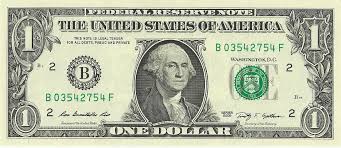记忆方法
dollar 【都乐】 元(美,加拿大等国的货币单位)
2. 该词还被戏谑地音译为“刀”,所以称“美元”为“美刀”。
2. 该词还被戏谑地音译为“刀”,所以称“美元”为“美刀”。
中文词源
dollar 美元
来自德语taler, 货币单位,词源同dale, 山谷,因铸造于Joachimstal而得名。后于1785年,dollar被美国国会采用作为基准货币单位。
英语词源
- dollar
-
dollar: [16] English originally acquired the word dollar in the form doler; this was the Low German form of German taler, a large silver coin in use in the German states from the 16th century. The word was short for Joachimstaler, literally ‘of Joachim’s valley’, and is a reference to the fact that silver from which the coins were made was mined near Joachimstal (modern Jachymov) in the Erzgebirge mountains, Czech Republic. By around 1700 the spelling dollar had become fairly standard, and in 1785 the term was formally adopted for the main unit of currency in the USA. It has since been taken up by over thirty countries around the world.
=> dale - dollar (n.)
- 1550s, from Low German daler, from German taler (1530s, later thaler), abbreviation of Joachimstaler, literally "(gulden) of Joachimstal," coin minted 1519 from silver from mine opened 1516 near Joachimstal, town in Erzgebirge Mountains in northwest Bohemia. German Tal is cognate with English dale.
The thaler was a large silver coin of varying value in the German states (and a unit of the German monetary union of 1857-73 equal to three marks); it also served as a currency unit in Denmark and Sweden. English colonists in America used the word in reference to Spanish pieces of eight. Due to extensive trade with the Spanish Indies and the proximity of Spanish colonies along the Gulf Coast, the Spanish dollar was probably the coin most familiar in the American colonies and the closest thing to a standard in all of them; it was used in the government's records of public debt and expenditures; it had the added advantage of not being British. The Continental Congress in 1786 adopted dollar as a unit when it set up the modern U.S. currency system, which was based on the suggestion of Gouverneur Morris (1782) as modified by Thomas Jefferson. None were circulated until 1794 .When William M. Evarts was Secretary of State he accompanied Lord Coleridge on an excursion to Mount Vernon. Coleridge remarked that he had heard it said that Washington, standing on the lawn, could throw a dollar clear across the Potomac. Mr. Evarts explained that a dollar would go further in those days than now. [Walsh]
Phrase dollars to doughnuts attested from 1890; dollar diplomacy is from 1910. The dollar sign ($) is said to derive from the image of the Pillars of Hercules, stamped with a scroll, on the Spanish piece of eight. However, according to the Bureau of Engraving and Printing of the U.S. Department of the Treasury:[T]he most widely accepted explanation is that the symbol is the result of evolution, independently in different places, of the Mexican or Spanish "P's" for pesos, or piastres, or pieces of eight. The theory, derived from a study of old manuscripts, is that the "S" gradually came to be written over the "P," developing a close equivalent of the "$" mark. It was widely used before the adoption of the United States dollar in 1785.
权威例句
- 1. In early trading in Tokyo, the dollar fell sharply against the yen.
- 在东京市场早市开盘时,美元对日元的比价急剧下跌。
- 2. The drop was caused partly by the pound's strength against the dollar.
- 下降的部分原因在于英镑对美元的升值。
- 3. The dollar fell to within a hair's breadth of its all-time low.
- 美元差一点跌到了最低点。
- 4. Until now, a devaluation of the dollar seemed inconceivable.
- 直到现在,美元的贬值似乎都无法想象。
- 5. The US dollar continued its strong performance in Tokyo today.
- 美元今天在东京继续保持强劲的走势。

